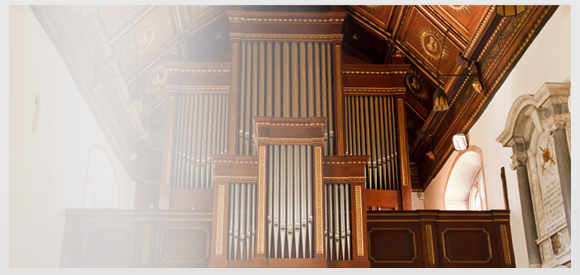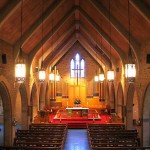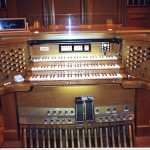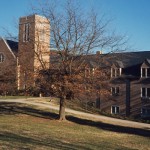Grace Episcopal Church
Grace Episcopal Church was organized as St. George’s Chapel in 1885, a
mission of St. Paul’s Episcopal Church. It was located at the corner of
19th and Cowart Streets. The church was named Grace Memorial Episcopal
Church in 1887 as a result of the donation of the church building by the
Richmond family in memory of their daughter, Grace, who died that year of
typhoid fever. The area quickly became one of industiry and, by 1907,
attendance had dwindled down to about 3 active parishioners.
That same year, they moved to Highland Park, which was then the eastern
frontier of Chattanooga. The 19th and Cowart property was not sold until
1957, when it was purchased by the Austin Motor Co. The congregation was
not officially reorganized until 1912. A new facility was completed in
1915. A packed church for the funeral of parishioner T C Thompson in 1938
pursuaded the congregation that larger facilities were needed.
In 1941, the church bought a large 1902 home at the corner of Belvoir and
Brainerd and moved in, dropping the world “Memorial” from its name in 1942.
It was not until 1956 that the parish moved into its new 400-seat nave and
undercroft, built on the site of the old home. The south wing was added in
1961.
A small Baldwin organ was first used in the nave, but, by the time the
parish bought the organ, it was already “on its last tubes.” Right around
this time, the Montague mansion on Cameron Hill was falling victim to the
downtown Golden Gateway urban renewal project. The Montague family donated
the home’s 1907 Pilcher organ, Opus 584, a two-manual with 20 stops, to the
parish. Parishioners disassembled and moved the organ to the church, where
it was reassembled under the eye of Norville Hall, a person from Mentone who
worked on organs in the area. A three-manual supply house console was added.
The pipework was placed in a chamber located near ceiling level on the south side of the chancel.
Henry Pilcher’s Sons, Op. 584, 1907/c1960, 3-manual
GREAT
8′ Open Diapason
8′ Gross Flute
8′ Gamba
8′ Dulciana
4′ Octave
4′ Flute d’Amour
4′ Dulcet
2 2/3′ Twelfth
2′ Fifteenth
8′ Clarinet
8′ Oboe (reedless)
SWELL
16′ Bourdon
8′ Open Diapason
8′ Stopped Diapason
8′ Salicional
8′ Voix Celeste
8′ Aeoline
4′ Fugara
4′ Flute Harmonique
4′ Salicet
2 2/3′ Nazat
2′ Piccolo
8′ Oboe
CHOIR
8′ Viola
8′ Stopped Flute
4′ Flute d’Amour
4′ Violina
2 2/3′ Nazard
2′ Flute
1 1/3′ Larigot
1′ Sifflote
PEDAL
16′ Open Diapason
16′ Gedeckt
8′ Open Diapason
8′ Flute
8′ Cello
4′ Choralbass
2 2/3′ Twelfth
2′ Fifteenth
In preparation for the installation of a new organ in 1986, the Pilcher was
given to the Episcopal Church of St. Joseph the Workman in Sevierville. It
was placed in storage, where it still remains.
The Moller organ was installed in 1986 when Dean Hunt was organist. The
dedication recital was performed on February 22, 1987, by Dr. Walker L.
Breland. The organ is installed across the front of the church, behind the
choir. It is basically a large two-manual design – the bottom of the three
manuals is home only to the Festival Trumpet.
M. P. Moller, Inc., Opus 11706, 1986, 3/36
GREAT
16′ Pommer
8′ Principal
8′ Gedackt
8′ Gemshorn
4′ Octave
4′ Rohrgedackt 24
2 2/3′ Nazard
2′ Waldflote
1 3/5′ Tierce
IV-V Mixture
8′ Trompette
Tremulant
Sub
Unison Off
Super
Bells
SWELL
8′ Rohrflote
8′ Viole Pomposa
8′ Viole Celeste
4′ Principal
4′ Koppelflote
2′ Octave
IV-V Plein Jeu
16′ Fagott
8′ Trompette
8′ Hautbois 12
4′ Schalmei
Tremulant
Sub
Unison Off
Super
FANFARE
8′ Festival Trumpet 8″ wp
Sub
Unison off
Super
Harp prep
Celesta prep
PEDAL
32′ Untersatz res
16′ Principal
16′ Pommer GT
8′ Octave
8′ Bordun GT
4′ Choralbass
4′ Rohrbordun GT
III Mixture
32′ Reed Cornet —
16′ Posaune
16′ Fagott
8′ Trompete 12
4′ Klarine 12







